Archaeologists have discovered something as valuable as the Roman Pompeii – a Bronze Age settlement that contains the “best-preserved Bronze Age dwellings ever found” in the country. Pots with meals still inside have been found at the site.

Archaeologists from Cambridge University have been working at the Cambridgeshire site, beneath the Must Farm quarry, since September, and by now they have a pretty good idea of what happened there. The settlement consisted of circular wooden houses that housed an extended family of around 10 people. The houses were built on stilts above water, and when a fire started to spread and destroyed the stilts, the houses collapsed into the river, where muddy sediments helped to preserve them very well.
Sadly, just like Pompeii, a disaster seems to be the key for the good preservation. Duncan Wilson, chief executive of Historic England, which is funding the project, said:
“A dramatic fire 3,000 years ago combined with subsequent waterlogged preservation has left to us a frozen moment in time, which gives us a graphic picture of life in the Bronze Age.”

The Bronze Age in Britain kicked in approximately 2500 BC and lasted up until 800-650 BC, ending when migratory people brought in iron from overseas. These huts date from 1000-800 BC, towards the end of the Bronze Age and could help us better understand how people lived back then.
“We are learning more about the food our ancestors ate, and the pottery they used to cook and serve it. We can also get an idea of how different rooms were used,” Wilson said, adding that the importance of this finding is global and not regional. “This site is of international significance and its excavation really will transform our understanding of the period.”
So far, aside from the houses, archaeologists have found pots and pans of varying sizes, spears and daggers, exotic glass beads and even textiles that had been fashioned from tree bark. The textiles seem to have been created from lime tree bark. Digs have also uncovered “exotic” glass beads that formed part of a necklace which hints “at a sophistication not usually associated with the Bronze Age”.

David Gibson, from Cambridge Archaeological Unit, which is leading the excavation, said:
“So much has been preserved, we can actually see everyday life during the Bronze Age in the round. It’s prehistoric archaeology in 3D, with an unsurpassed finds assemblage both in terms of range and quantity.”
Most other sites don’t even begin to compare with it.
“Most don’t have any timber remaining, just post-holes and marks where posts would have been,” he said. “So far this is unique as we have the roof structure as well.”
Work must be carried on as fast as possible at the site, because there are concerns that water levels will rise in late winter and spring and could wash away some of the artifacts and structures.






